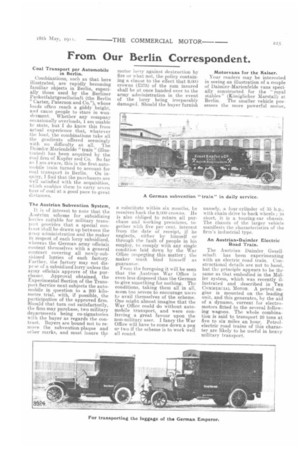From Our Berlin Correspondent.
Page 19

If you've noticed an error in this article please click here to report it so we can fix it.
Coal Transport per Automobile in Berlin.
Combinations, such as that here illustrated, are rapidly becoming familiar objects in Berlin, especially those used by the Berliner Packelfahrtgesellschaft (the Berlin "Carter, Paterson and Co."), whose loads often reach a giddy height, and cause people to stare in won derment. Whether any company occasionally overloads, I am unable to state, but I do know this front actual experience that, whatever the load, the combinations take all the gradients offered seemingly with no difficulty at all. The Da imlor-Marienfelde " train " (illustra ted) has been acquired by the coal firm of Kupfer and Co. So far as I am aware, this is the first automobile train turned to account for coal transport in Berlin. On inquiry, I find that the purchasers are well satisfied with the acquisition, which enables them to carry seven toas of coal at a good pace to great distances.
The Austrian Subvention System, It is of interest to note that he Ausl rian scheme for subsidizing lorries suitable for military transport provides that a special contract shall be drawn up between the army administration and the maker in respect of each lorry subsidized, whereas the German army officials content themselves with a general contract covering all newly-subsidized lorries of each factory. Further, the factory may not dispose of a subsidized lorry unless the army officials approve of the purchaser. Approval obtained, the Experimental Section of the Transport Service next subjects the automobile in question to a 200 kilometre trial, with, if possible, the participation of the approved firm. Should that turn out satisfactorily, the firm may purchase, two military departments being co-signatories with the buyer as regards the contract. Buyers are bound not to remove the subvention-plaque and other marks, and must insure the
motor lorry against destruction by fire or what not, the policy containing a clause to the effect that 9,000 crowns (g375) of the sum insured shall be at once handed over to the army administration in the event of the lorry being irreparably damaged. Should the buyer furnish
a substitute within six months, he receives back the 9,000 crowns. He is also obliged to return all purchase and working premiums, together with five per cent, interest from the date of receipt, if he neglects, either by himself or through the fault of people in his employ, to comply with any single condition laid down by the War Office respecting this matter ; the maker must bind himself as guarantor.
From the foregoing it will be seen that the Austrian War Office is even less disposed than the German to give something for nothing. The conditions, taking them all in all, seem too severe to encourage users to avail themselves of the scheme. One might almost imagine that the War Office could do without automobile transport, and were conferring a great favour upon the non-military user. I fancy the War Office will have to come down a peg or two if the scheme is to work well all round.
Niotorvans for the Kaiser.
Your readers may be interested in seeing an illustration of a couple of Daimler-Marienfelde vans specially constructed for the " royal stables" (_Koniglicher Marstall) at Berlin. The smaller vehicle possesses the more powerful motor,
namely, a four-cylinder of 35 h.p., with chain-drive to back wheels ; in short, it is a touring-car chassis. The chassis of the larger vehicle manifests the characteristics of the firm's industrial type.
An Austrian-Daimler Electric goad Train.
The Austrian Daimler Gesellschaft has been experimenting with an electric road train. Constructional details are not to hand, but the principle appears to be the same as that embodied in the Miller system, which was recently illustrated and described in THE. Coataititerm, MoTott. A petrol engine is mounted on the leading unit, and this generates, by the aid of a dynamo, current for electromotors fitted to the several following wagons. The whole combination is said to transport 20 tons at five to six miles an hour. Petrolelectric road trains of this character are likely to be useful in heavy military transport.


























